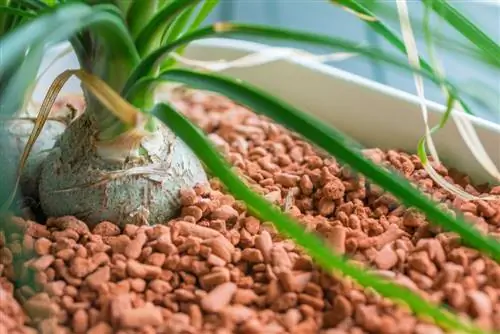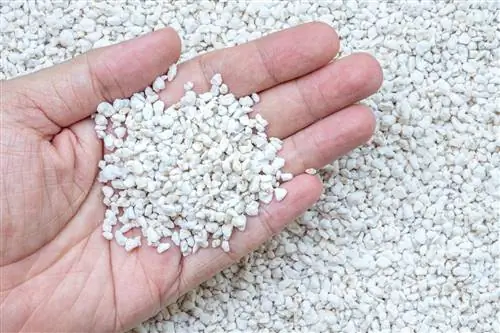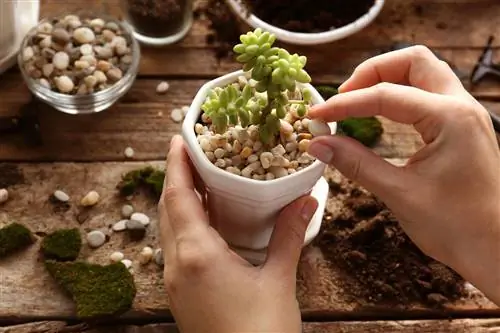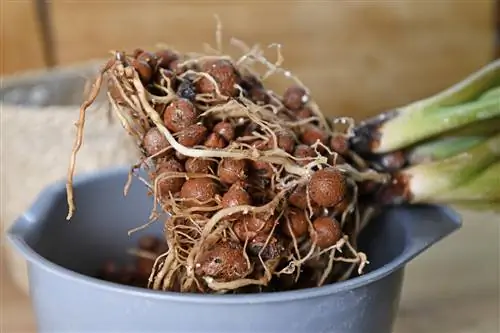- Author admin [email protected].
- Public 2023-12-16 16:46.
- Last modified 2025-06-01 06:02.
Expanded clay or clay granules offer some tangible advantages, especially for houseplants. To ensure that your plants benefit from them, you can find out all the important tips for using the fired clay balls here - plus tips for purchasing high-quality material.
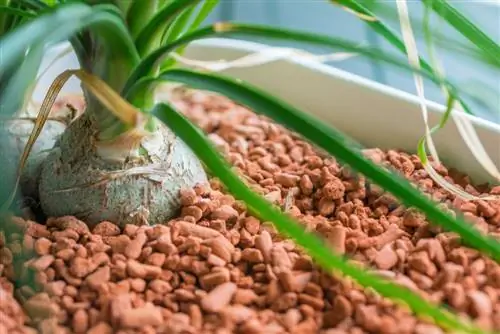
What is clay granules and what is it used for?
Clay granulate, also known as expanded clay, is a material consisting of fired clay balls that can be used as a replacement for potting soil or in combination with it. It has a high water storage capacity and is ideal for caring for houseplants. However, it is nutrient-free and requires regular fertilization.
- Clay granules consist of fired clay balls and can be used very well as a replacement for potting soil.
- Alternatively, you can also mix the material with potting soil and thus improve the water storage capacity of the substrate.
- Clay granules have a very high water storage capacity, which is why you have to water houseplants grown in them less often.
- However, there are some special features to consider when caring for these plants. Since clay granules do not contain any nutrients, you must regularly supply these plants with a special fertilizer.
What is clay granules?
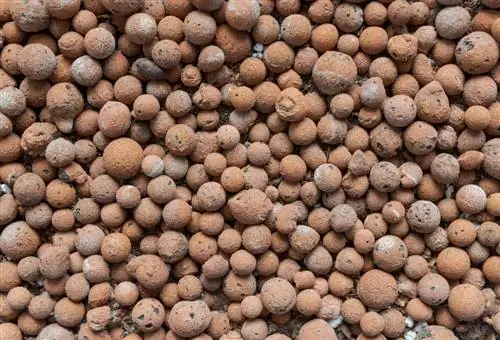
Clay granulate is literally granules made from clay
Clay granules are, as the name suggests, made from clay. This is a particularly fine-grained type of soil that is created by the decomposition of rock spates (again a collective name for various types of rock). Clay is considered to hold water well, a property that is further improved and optimized through the process of producing clay granules. To do this, clay is ground, granulated and then fired at extremely high temperatures of around 1200 degrees Celsius.
During this process, the organic substances contained in the raw material burn, producing carbon dioxide. The gas in turn expands the granules so that the typical round balls are formed. Clay granules have a porous surface and are therefore able to absorb and store water. For this reason, the material is ideal as a sole or additional substrate for houseplants, but also for other purposes. You can find out what you can use clay granules for and what you should pay attention to in the following sections.
Types of clay granules
There are different types of clay granules that differ in these properties:
- Grain
- pH value and salinity
- Suitability for plant species
Clay granules are available in different grain sizes, i.e. H. the beads vary in size depending on the product. A grain size of 4/8 is suitable for most houseplants, as the plant roots find the best grip here - the small balls with diameters between four and eight millimeters fill gaps well and leave only a few cavities. However, they only let a little air through, which is why you should use a coarser grain size such as 8/16, especially for larger house plants.
There are also differences between the pH and s alt content of the different products. Most clay granules have a pH of around 7 and are therefore suitable for most plants. On the other hand, if you need a slightly acidic substrate for your plants, Seramis is a good choice. When it comes to s alt content, there are differences between the individual products between two and 920 milligrams per 100 grams of clay granules. If you want to plant your houseplants hydroponically or cultivate s alt-sensitive species, choose a product with less than 250 milligrams of s alt per 100 grams of clay granules.
Advantages and disadvantages

The most important positive property of clay granules is its ability to store water and gradually release it back to the plants as needed. Therefore, plants grown in this material need to be watered much less often. This table clearly shows you the advantages and disadvantages of clay granules compared to conventional potting soil.
| Advantages | Disadvantages |
|---|---|
| durable, can be used again and again | expensive |
| good water storage | contains no nutrients |
| ensures consistent water supply | regular fertilization essential |
| air permeable | Moisture content cannot be seen or felt from outside |
| prevents root rot | Water level indicator therefore indispensable |
| no fungus gnats and other pests that lay their eggs in soil | low weight, fluctuates due to water intake and release |
| clean and suitable for allergy sufferers | larger plants in particular are at risk of tipping over without being weighed down |
| doesn't mold |
Excursus
Why a water level indicator is essential when using clay granules
A water level indicator is a type of thermometer for the flower pot. However, this does not show you the temperature, but rather the water content of the substrate. Since, in contrast to potting soil, you cannot estimate the water content of clay granules by sight or feel, such a device is indispensable. All you need to do is look at the display: If it says “minimum”, you need to water.
What can clay granules be used for?
Clay granules are probably used most frequently in the care of houseplants, which is why we would like to introduce three relevant areas of application to you here. But there are also various possible uses in aquariums, terrariums, for green roofs or when building ponds.
Hydroculture
With hydroponics, you plant and care for your houseplants exclusively in clay granules. However, it is not enough to simply replace the potting soil with expanded clay. On the one hand, switching to hydroponics requires careful washing of the roots so that no soil remains, but on the other hand, you need special planting systems. These usually consist of an inner and an outer pot. In the inner pot you place the plant in the substrate, while the outer pot contains the water, which needs to be topped up regularly together with the nutrient solution.
Conversion to hydroponics - This is how it works
The conversion to hydroponics works as follows:
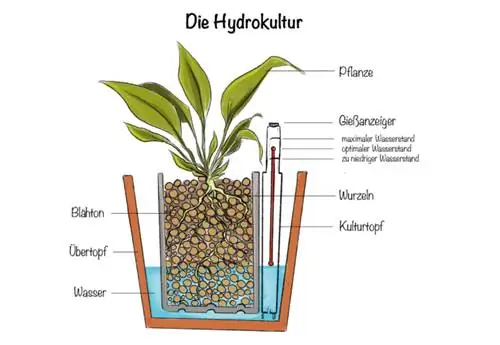
- Pot out the plant.
- Remove the soil. Rinse out any residue from the root ball completely.
- Short roots that are too long; brown (rotten) roots will also be cut off.
- Pour a layer of expanded clay into the inner pot.
- Place the plant on top and fill the inner pot.
- Tap the bottom lightly on the table to close gaps.
- Place the inner pot in the planter.
- Fill with lukewarm water and don't forget the water level indicator.
Soil balls in clay granules - simplified hydroponics
It is less complicated to leave the root ball of the plants intact (and covered with soil). Instead, simply place the plant to be repotted with the soil-covered root ball in a surrounding layer of clay granules. Here the roots are practically embedded in the new additional substrate, but are still in soil. The water level indicator should not be missing here either.
Drainage for houseplants - mix clay granules with soil
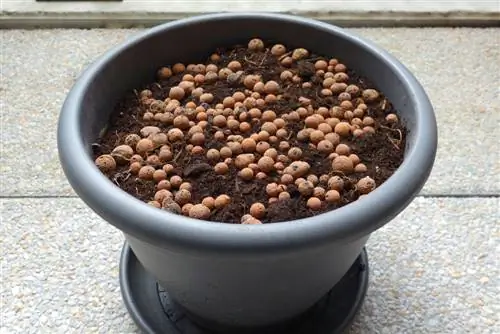
Mixing soil with clay granules saves watering
Alternatively, mix the clay granules with the potting soil to improve its water-storing properties or to guarantee an optimal supply of moisture. You have different options:
- For pot drainage, add a layer of expanded clay to the bottom of the pot.
- Depending on the pot size, this should be between two and ten centimeters thick.
- First place a piece of clay over the drain hole so that it doesn't get blocked.
- Mix the potting soil with fine expanded clay balls.
- For a pot with a diameter of 15 to 20 centimeters you need about a handful.
A water level indicator is not absolutely necessary in this case, but it can make it much easier for you to determine the right time to water.
Excursus
Cracked clay granules for pond plants
Instead of lining the garden pond with foil or using a pre-formed plastic tray, you can also use clay to seal it. Clay blocks made from moist material or broken clay granules (swelling clay) are suitable for this purpose. The clay layer on the bottom of the pond should be between 10 and 20 centimeters thick, depending on the size of the pond.
Where can you buy clay granules?
“Plants need a good substrate in order to find support and to draw nutrients and water from it.”
Clay granules can be purchased either as a branded product (€19.00 on Amazon) (e.g. B. Floragard, Seramis or Dehner) or as a no-name product (e.g. own brands from hardware and garden stores such as Obi, discount brands). Common pack sizes include between 2, 5 and 50 liters of different contents, depending on what you have in mind. You can find larger quantities, such as those you need for sealing garden ponds, in special shops.
Frequently asked questions
Is there a difference between expanded clay and clay granules?
The terms expanded clay and clay granulate both refer to fired, reddish colored clay balls. So there is no difference in meaning between them, although there may be differences between the individual products and manufacturers - for example in terms of grain size or intended use. Another name for clay granules is plant clay.
Can I completely replace the potting soil with clay granules?
Used correctly - as described in the article - clay granules can actually completely replace potting soil. However, you then have to take some special considerations into account when caring for your houseplants, such as the fact that using them alone without a water level indicator doesn't work or that you have to fertilize them regularly. With clay granules, it is not possible to determine whether the plants need water with a simple finger test. Since the material is also inorganic, it does not contain any nutrients. These must be supplied continuously.
Is clay granules poisonous?
No, clay granules are generally not poisonous. After all, it is a natural material that has only been burned and thus made structurally stable. Chemical additives are not added to most products. You still shouldn't eat the material, that's not what it's intended for and it wouldn't be particularly good for you - your body can't digest it. Instead, the beads could remain in the gastrointestinal tract and cause serious blockages.
Tip
Many resourceful houseplant gardeners have come up with the idea of using compostable cat litter (e.g. based on bentonite) instead of clay granules. Although this has very similar properties to expanded clay in terms of its water storage capacity, it is not suitable as a plant substrate due to the often very high pH value. The reason is the high lime content of the material, whereas most houseplants need a slightly acidic to neutral pH value for their well-being.

